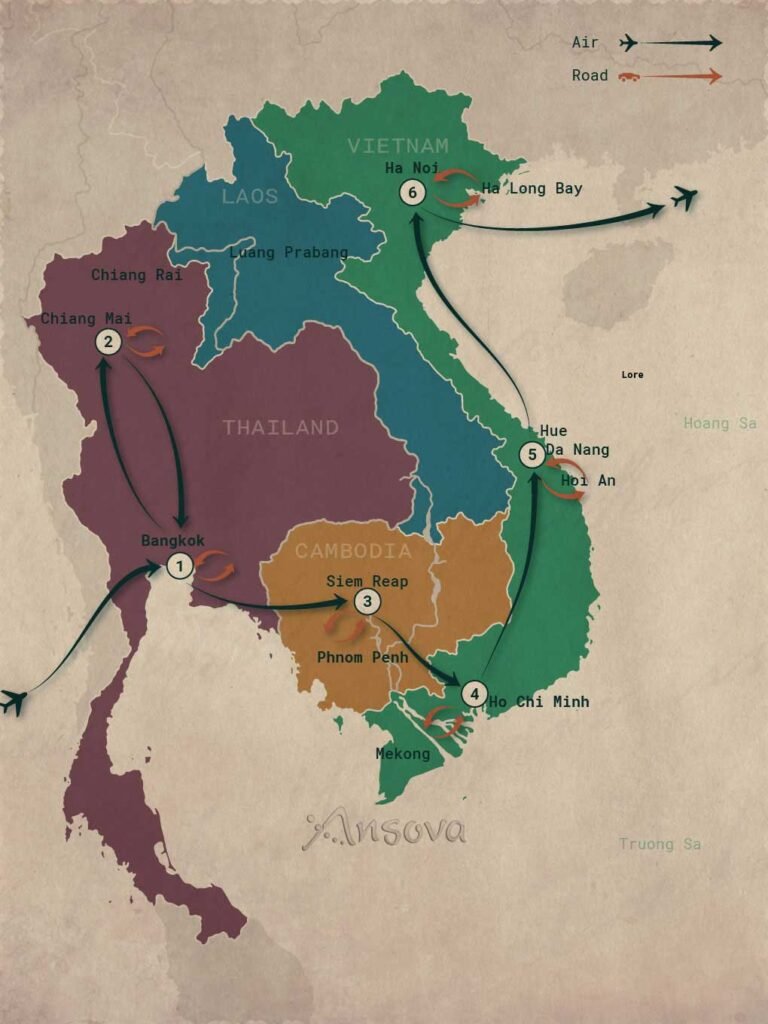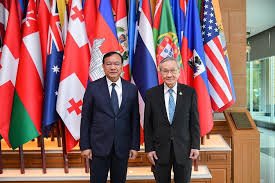Thailand and Cambodia share a complex and multifaceted relationship characterized by a mix of historical, cultural, economic, and geopolitical factors. This relationship has undergone significant transformations over the years, marked by periods of cooperation, conflict, and diplomatic tensions. In this essay, I will explore the historical background, key dimensions, and contemporary dynamics of Thailand-Cambodia relations, aiming to provide a comprehensive understanding of this important bilateral relationship.
Historical Background:
The historical ties between Thailand and Cambodia date back centuries, shaped by interactions ranging from trade and cultural exchange to territorial disputes and military conflicts. The ancient Khmer Empire, centered in present-day Cambodia, exerted significant influence over the region, including parts of what is now Thailand, during its peak from the 9th to the 15th centuries. The architectural marvels of Angkor Wat and other Khmer temples stand as testaments to this period of Khmer dominance.
However, the relationship between the Khmer Empire and the various Thai kingdoms was not always peaceful. Border disputes and competition for territory often led to conflicts between the two powers. Over time, the Thai kingdoms gradually expanded their influence, sometimes at the expense of Khmer territory, while also absorbing elements of Khmer culture and religion.
In more recent history, the colonial era further complicated the relationship between Thailand and Cambodia. Both countries experienced colonization by European powers, with Cambodia falling under French rule while Thailand managed to maintain its independence. This period of colonialism left a lasting impact on the socio-political landscape of the region and contributed to the shaping of modern-day Thailand and Cambodia.

Post-Independence Era:
Following the end of World War II and the decline of colonialism, Thailand and Cambodia emerged as independent nations seeking to assert their sovereignty and pursue their respective national interests. The post-independence era saw a mix of cooperation and tension between the two countries, influenced by Cold War dynamics, regional geopolitics, and domestic politics.
One of the defining moments in Thailand-Cambodia relations occurred in the late 20th century with the rise of the Khmer Rouge in Cambodia. The brutal regime led by Pol Pot not only caused immense suffering to the Cambodian people but also posed a security threat to neighboring countries, including Thailand. The Thai government initially supported the Khmer Rouge as a buffer against Vietnamese influence but later shifted its stance as the atrocities committed by the regime became apparent.
The 1979 Vietnamese invasion of Cambodia, which ousted the Khmer Rouge from power, further complicated the regional dynamics. Thailand, along with other ASEAN countries, opposed the Vietnamese occupation and supported the formation of the Coalition Government of Democratic Kampuchea (CGDK), which included the Khmer Rouge, as a means to counter Vietnamese influence in Cambodia.
Border Disputes and Territorial Issues:
One of the most contentious issues in Thailand-Cambodia relations has been the border disputes over territory surrounding the Preah Vihear temple complex. The temple, which is situated on a cliff in the Dângrêk Mountains, has been a point of contention between the two countries for decades. Both Thailand and Cambodia lay claim to the area surrounding the temple, leading to periodic flare-ups of tensions and even military clashes.
In 1962, the International Court of Justice (ICJ) ruled in favor of Cambodia, confirming its sovereignty over the temple. However, the issue remained unresolved, and sporadic skirmishes continued to occur along the border. Tensions escalated again in 2008 when UNESCO designated the Preah Vihear temple as a World Heritage Site, reigniting nationalist sentiments on both sides and resulting in armed clashes between Thai and Cambodian troops.
The border disputes over Preah Vihear underscore the challenges of managing territorial issues between neighboring countries with complex historical legacies and competing national interests. Efforts to find a lasting solution to the dispute have been hampered by domestic politics, nationalist sentiments, and a lack of trust between the two governments.

Economic Relations:
Despite the historical and geopolitical challenges, Thailand and Cambodia have developed strong economic ties in recent decades. Trade and investment between the two countries have grown significantly, driven by geographical proximity, complementarity of economies, and efforts to enhance regional integration through organizations such as ASEAN.
Thailand is one of Cambodia’s largest trading partners, with bilateral trade volumes reaching billions of dollars annually. Key sectors of cooperation include agriculture, manufacturing, tourism, and cross-border infrastructure development. Thai companies have made significant investments in Cambodia, particularly in the real estate, hospitality, and manufacturing sectors, contributing to economic growth and job creation in both countries.
The close economic relationship between Thailand and Cambodia has also been facilitated by infrastructure projects aimed at improving connectivity and trade facilitation. Initiatives such as the construction of roads, bridges, and special economic zones along the border have helped to enhance cross-border trade and investment flows, despite occasional disruptions caused by political tensions or regulatory barriers.
Cultural and People-to-People Ties:
Cultural exchanges and people-to-people ties have long been an integral part of Thailand-Cambodia relations, reflecting shared historical, linguistic, and religious heritage. The Theravada Buddhist tradition, which is prevalent in both countries, serves as a unifying cultural element and provides a basis for mutual understanding and cooperation.
Tourism plays a significant role in promoting cultural exchange and fostering goodwill between Thailand and Cambodia. Millions of Thai tourists visit Cambodia each year to explore its ancient temples, scenic landscapes, and vibrant culture, while Cambodian tourists also travel to Thailand to experience its bustling cities, pristine beaches, and rich cultural attractions.
In addition to tourism, educational and cultural exchanges between Thailand and Cambodia have expanded in recent years, supported by government initiatives, academic institutions, and civil society organizations. Programs such as student exchanges, language courses, and cultural festivals contribute to greater mutual understanding and appreciation of each other’s heritage and traditions.
Diplomatic Relations and Regional Cooperation:
Thailand and Cambodia maintain diplomatic relations and are both active members of regional organizations such as ASEAN, where they collaborate on various economic, political, and security issues. Despite occasional differences and disputes, both countries recognize the importance of regional stability and cooperation in promoting peace, prosperity, and development in Southeast Asia.
Within ASEAN, Thailand and Cambodia have worked together to address common challenges such as transnational crime, natural disasters, and regional integration. They have also participated in multilateral forums and initiatives aimed at enhancing connectivity, trade liberalization, and sustainable development in the region.

At the bilateral level, efforts to strengthen diplomatic ties and promote cooperation have continued through high-level visits, diplomatic exchanges, and joint projects in areas such as infrastructure development, environmental conservation, and cultural exchange. While differences and occasional tensions may arise, both countries have demonstrated a commitment to resolving disputes through peaceful means and maintaining constructive engagement at the regional and international levels.
Thailand-Cambodia relations are characterized by a complex interplay of historical, cultural, economic, and geopolitical factors. Despite periods of tension and conflict, both countries have managed to cultivate a multifaceted relationship based on mutual interests, cooperation, and shared aspirations for peace and development in the region.
While challenges such as border disputes, historical grievances, and political differences may persist, the overall trajectory of Thailand-Cambodia relations points towards greater integration, connectivity, and collaboration in the years to come. By building on areas of mutual benefit, promoting dialogue and understanding, and leveraging regional frameworks for cooperation, Thailand and Cambodia have the potential to further enhance their bilateral ties and contribute to the stability and prosperity of Southeast Asia as a whole.
